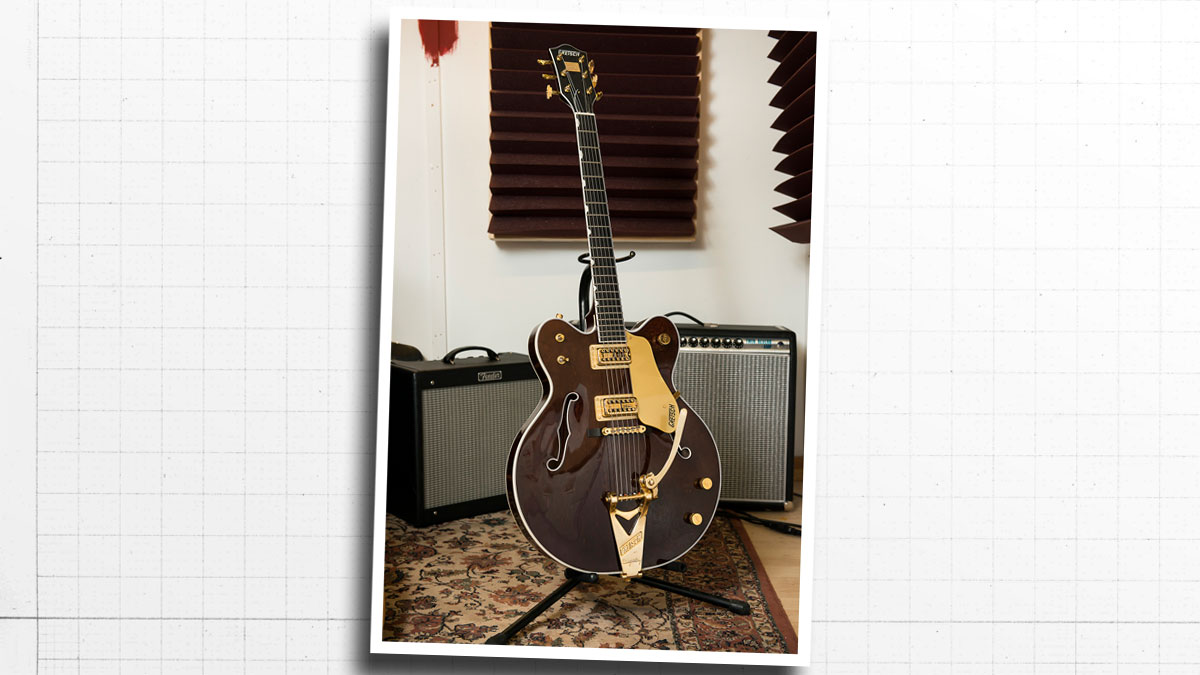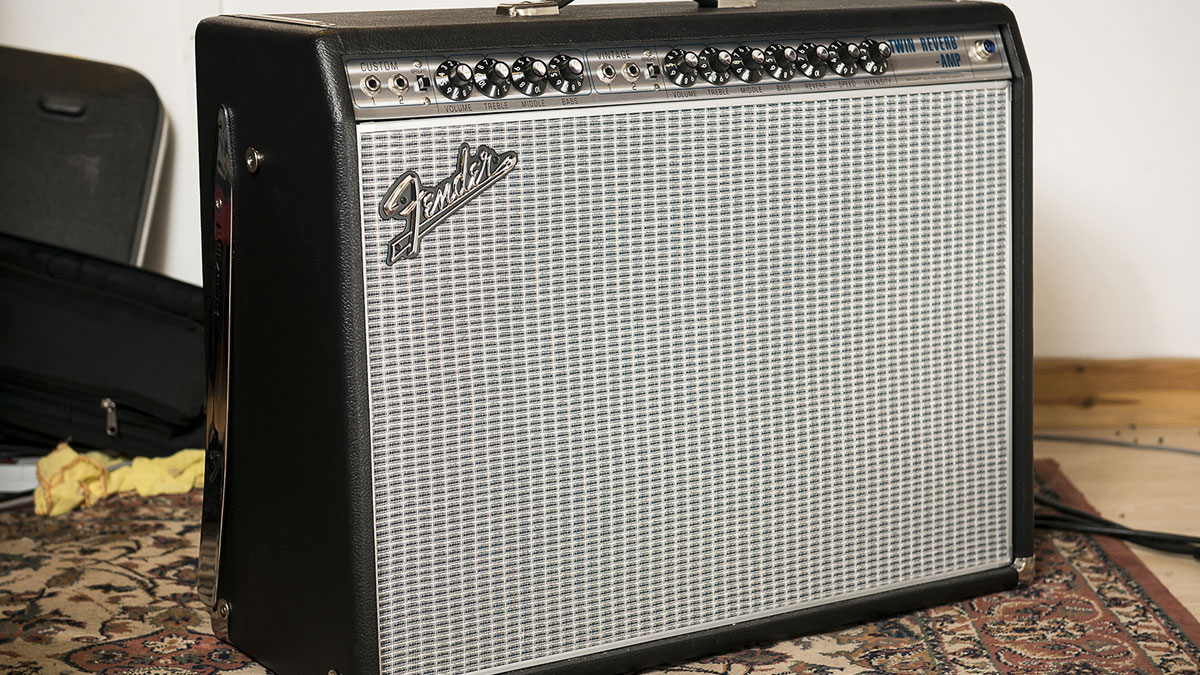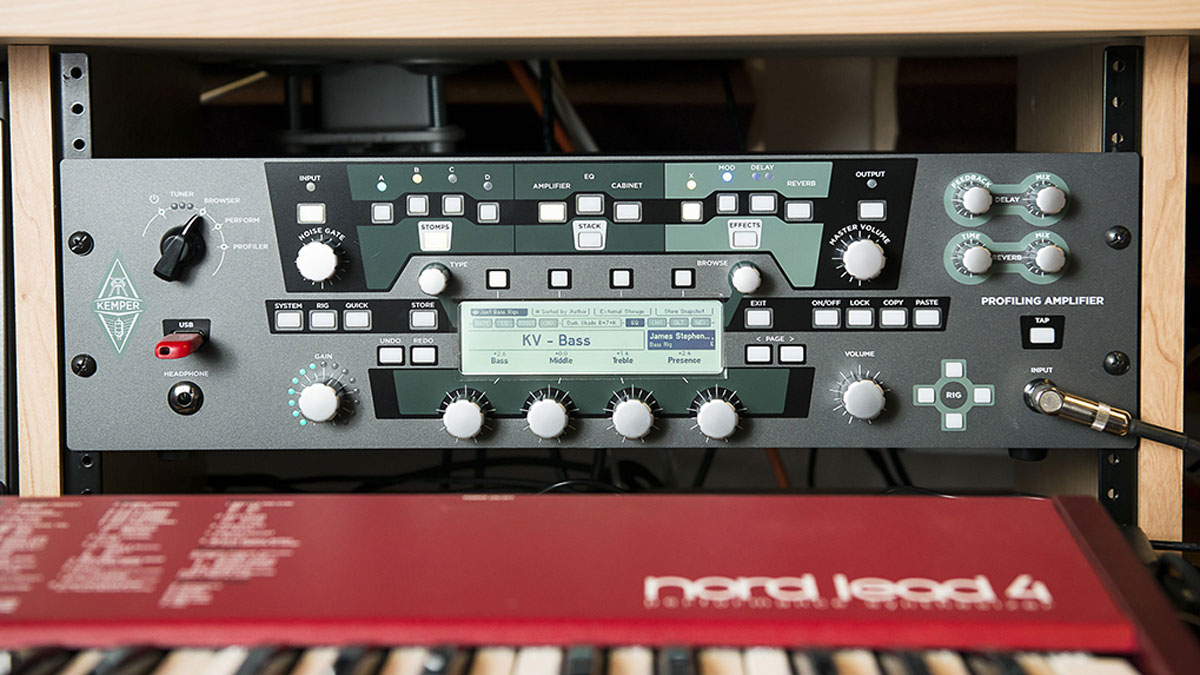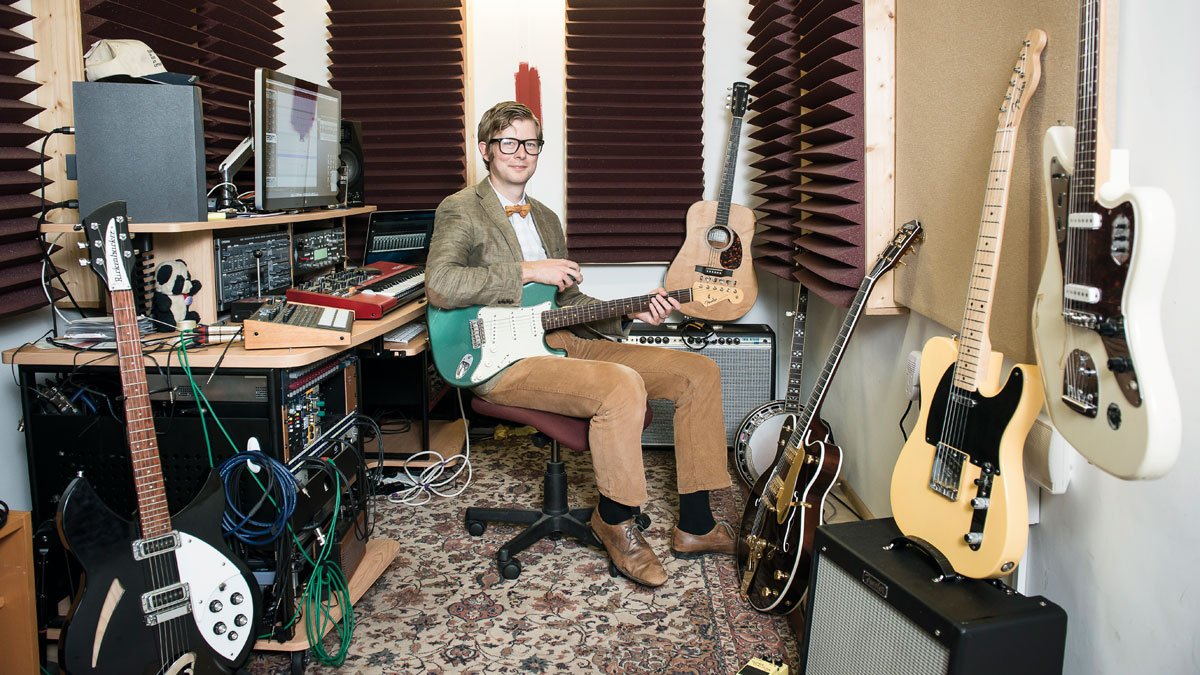Public Service Broadcasting on looping, sampling and guitar gear
J Willgoose Esq on his six-string influences

Introduction
Superimposing loops, electronica and live guitar on old filmstock is all in a day’s work for Public Service Broadcasting… Pathé News meets indie rock!
Public Service Broadcasting and their tweed-attired leader J Willgoose Esq have been pioneering their unique mix of sample-strewn cinematic electronica and melodic indie-rock for over half a decade.
Dramatic compositions are often centred around sample threads taken from the British Film Institute’s vast library of archival footage
While their two albums - Inform-Educate-Entertain (2013) and The Race For Space (2015) - have both garnered significant critical acclaim, as well as impacting the upper reaches of the album charts, the duo have also built a reputation for being a major crowdpleaser on the festival circuit.
J Willgoose’s dramatic compositions are often centred around sample threads taken from the British Film Institute’s vast library of archival footage and public information films. The conquering of Everest, the Blitz and the Apollo program are just a few of the concept-based tracks produced under the Public Service Broadcasting moniker.
From a musical perspective, the humble guitar is often as significant as the synths and samplers that litter both Willgoose’s home studio and the group’s onstage setups.
J, who counts Mogwai, Radiohead, The Walkmen and Manic Street Preachers as some of his main six-string influences, is also a master of looping, often going to impressive lengths to maintain a vibe fuelled feel to the band’s energetic shows.
We drop by the PSB recording HQ where J wields his unique magic, to talk complex loops, maligned banjos and J’s conversion to the joys of the Strat.
Don't Miss

Electronic soul
Public Service Broadcasting are commonly categorised as an electronic music outfit. How far do you think having live guitars, bass, drums and other instruments helps build a rapport with your audiences?
“Well, it is primarily electronic music at heart, or it certainly was at the start. I can get frustrated with watching electronic music live and how musically un-engaging it can be, and how you’re often not really given a lot to go on as an audience member in terms of what’s happening and what’s making the sounds in front of you.
We’re all keeping various balls in the air, but, I just think you have to focus on whatever the main instrument in the song is
“I find that really, really off-putting and alienating for the audience. Even putting together the solo shows back when it was just me was always about making certain sacrifices.
“You might have some stuff that does come off backing or that you’re not going to do live, but at the same time, you’re giving people an obvious, live spontaneous musical point of engagement - whether it’s the guitar or banjo, or adding a bass player, as we have done now.
“The drums are maybe the biggest part of it; they’re such a great instrument to watch. It’s a lot more work to do it that way, and to do all the looping stuff - which is very technical and takes a lot of preproduction - but it’s really paid off when we get in front of crowds who appreciate it.”
How do you balance playing guitar on stage versus synths and sequencers?
“I tend to operate on the principle of, ‘Try and do the most obvious musical element and try and do that live.’ I never have a lead line that’s not live, so I’ll either try and loop something before it or hand it off somewhere else and try and get somebody else to do it.
“Wriggles [Wrigglesworth, the other half of the duo] can do quite a lot of electronic stuff while I’m playing the guitar. We’re all doing various things and keeping various balls in the air, but, I just think you have to focus on whatever the main instrument in the song is and make sure you’re playing that - and that it is live.”

Software setup
What amplifiers do you use on stage?
“It’s actually all software live at the moment. All of it. And there’s a good reason for that, in that there’s so many loops happening that go into the computer and have to be processed in a certain way, going through one set of presets and then coming through another, I can’t see any other way of doing it unless you were to tour something the size of a bus!
“I’ve just bought this Kemper [Profiler profiling amp], so the early stages are there of taking it outside the box, although only into another box… but at least it’s a different kind of box! It’s Guitar Rig 4. It’s not even the most recent version.
Spitfire is actually the hardest: by the end, I’m doing one melody with right-hand keys and another melody with left-hand guitar
“I’ve got a Roland MIDI foot controller and just a little signal pad for when I’m using the Gretsch Country Gentleman, because it’s hotter than the rest of them, but otherwise it’s just straight into the sound card.”
Give us an example of a track that’s particularly complex to looping live…
“Spitfire is a good example. It starts off with just a very basic guitar riff, F octave picking and then going into F major picking. It’s an eight-bar loop, I think. So you play that once and you’ve only got one chance to play that: if you muck it up it’s going to go round and round… so make sure you don’t muck it up!
“As soon as the drums come in, I have to whack the pedal down to get the sort of wah tremolo effect - I’m doing that and muting it, so it’s going ‘digadigdugdug’ while the original one is still playing through the original preset.
“Once that’s looped, I go to the keyboard and loop the percussive keyboard part. Then I flip that up so it’s going to the octave as well, and then set it up for the next verse, and then quickly come back to the guitar in time to change the preset to do the solo for the chorus. At the end of the chorus, you flip back to another preset so the guitar isn’t feeding back horribly throughout the main bit.
“Spitfire is actually the hardest: by the end, I’m doing one melody with right-hand keys and another melody with left-hand guitar, and hammering on and stuff. I can’t think about it! If I think about it, I’m dead, basically, so I just let my hands do it.”

Concept recordings
Do you write many of your songs on guitar?
“Some of the writing starts on a guitar and some is done on synth. Go! started out on a synth and Everest is definitely a synth-based song. Spitfire started with just the guitar riff that you hear at the start. I knew I really liked it and it could be something good if I worked at it.
“Every single song comes from one very, very simple original idea that is then layered. Sometimes, the original idea is thrown away because you layer it up and it ends up going somewhere else and you realise you don’t need the original thing. It could be a guitar I start with, or it could be a banjo, or it could be something that is a more drummy, percussive idea.
Every single song comes from one very, very simple original idea that is then layered
“I just like mucking around on my phone and having the luxury of being able to record, loop stuff and try to work out melodies on top. As a guitarist, if there’s one area that I think I’m all right at, it’s probably melodic lines and actually coming up with something that’s relatively memorable and catchy to put on top of the more layered stuff.”
Is the third Public Service Broadcasting album going to be concept-based, too?
“I have got a concept for it, and I know in my head what the titles of about three or four of the songs are. I’ve also got musical ideas for them, but I haven’t yet seen any footage to match to them yet, but there should be some footage and I should be able to find it and I should be able to use it, hopefully.
“I’ve already made basic enquiries with BFI and other people about using certain footage. We kept the lid on The Race For Space until we were ready and we’ll do the same with this!”

The gear
Fender American Vintage ’59 Stratocaster (2014)
“I wrote Gagarin and there’s one section of it in particular where I was like, ‘Oh God! I’m going to have to buy a Strat! I hate Strats!’ So I tried a few out and found one I actually really liked.
“I ended up recording the song and then realised I really like Strats. They’re fantastic and extraordinarily versatile… but maybe they’re not viewed as that rock ’n’ roll any more and are more ‘establishment’.
“I remember John Squire said that playing a Strat on stage would be like wearing a school tie on stage and that’s been the attitude I had towards them ever since. But they’re beautiful, amazing guitars. Ever since I got it, I can’t stop playing it.”
Rickenbacker 330 (2002)
“The Rickenbacker 330 was my fi rst serious guitar and I love it. There used to be a band called Six By Seven; [Chris Olley] played a Rickenbacker and he played it in a way that I hadn’t heard before. I had never necessarily associated it with heavier music. If you catch it right, it’s just beautiful.”
Gretsch Country Gentleman (2014)
“My most recent guitar is the Gretsch Country Gentleman. I wrote a song and I felt that it needed to be a big sort of hollowbody sound, like a really big warm humbuck-y sound… That track was Valentina and it ended up being on Tomorrow as well - with really sort of gentle, nice picking to it - and it was also on The Other Side. It’s the guitar doing the really long delay and also the fi ngerpick-y stuff in the build-up.”
Larrivée dreadnought
“A beautiful-sounding guitar. I went in with the aim of buying a decent acoustic for about £400, but the guy in the shop saw me coming because he was like, ‘Try this!’ You know when you play a guitar and within two or three strums, you’re like ‘That’s it!’? It was the same with the Gretsch.”
Fender Twin Reverb
“Valentina and the more delicate stuff went through the Twin. It’s just all about having a real spring. You can emulate it, but being in the room with it and actually being able to feel the air hitting your face is just great. That’s defi nitely a direction I want to go more into in the future.”
Countryman Banjo
“It can give you different textures. It’s percussive, it’s upbeat, but you can also get a melancholy sound playing it in that more melodic style with the open strings and moving across strings more quickly… it’s surprisingly versatile.”
Fender Jaguar ’62 Reissue (Japanese, 1998)
“The oldest guitar in the setup is this Japanese 60s-reissue Jag, which is much loved, but not very well treated - so it’s not very reliable! That comes out occasionally.”
Fender Blues Junior
“Recording guitars, I use a mixture of going straight in and amps. The first album [Inform-Educate- Entertain, 2013] was all straight in, but I got a Twin and a Blues Junior for the second album. I used the little one on Go! to get that driving aggressive sound, where it’s slightly overdriven. Stick a Tele through that and it just sounds beautiful.”
Fender American Vintage ’52 Tele (2013)
“After the Rickenbacker, I think the next guitar I got was a Tele because I really like the aggression and the percussive bite you can get. There’s something about fast downstrokes on the Tele you can’t really get on another guitar.
“Go! was on the Tele. Most of Sputnik was done on that guitar. We did a really heavy drop D song [Elfstedentocht Part One] in between albums about Dutch ice skating, which was very definitely Tele… if it’s good enough for Rage Against The Machine, it’s definitely good enough for everyone else.”

